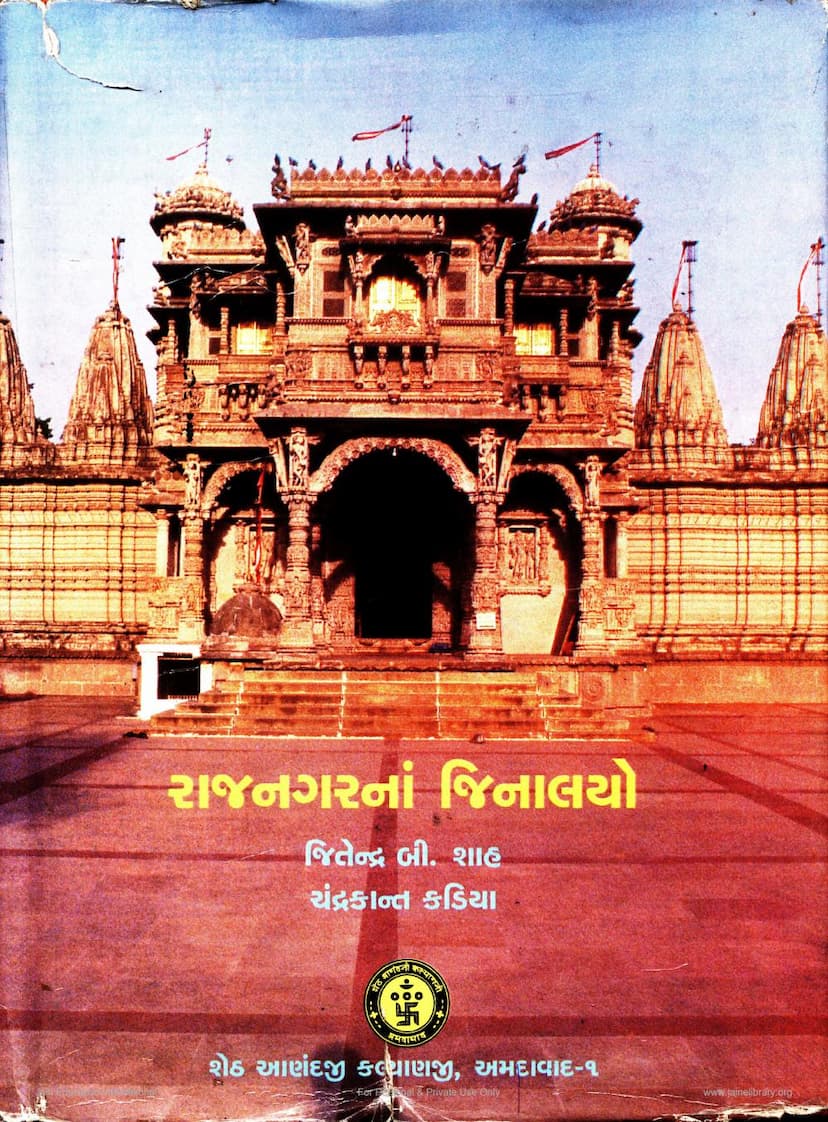Rajnagarna Jinalayo
Added to library: September 2, 2025

Summary
The book "Rajnagarna Jinalayo" (Temples of Rajnagar) by Jitendra B. Shah and Chandrakant Kadia, published by Anandji Kalyanji Pedhi, is a comprehensive historical and descriptive account of Jain temples in Ahmedabad, referred to as "Rajnagar."
Here's a summary of the key aspects covered in the text, based on the provided pages:
Core Theme: The book meticulously documents the history, architecture, and significance of Jain temples (Jinalayas) in Ahmedabad, highlighting the rich Jain heritage of the city.
Historical Context:
- Ahmedabad's Jain Legacy: The text emphasizes Ahmedabad's historical importance as a capital city for Jains for over five centuries. It notes that while many Jain temples have been destroyed or lost over time, a significant number still stand, reflecting the enduring Jain tradition.
- Evolution of Ahmedabad: The book traces the historical development of Ahmedabad, mentioning its earlier forms as Ashaval and Karnavati, and the Jain community's presence and influence throughout these periods.
- Patronage and Contributions: It highlights the crucial role of Jain patrons (Shreshthis) and saints in the construction, preservation, and propagation of Jainism. Their generosity, foresight, and dedication are credited for the magnificent Jinalayas and the flourishing of Jain culture.
- Adversities and Resilience: The text acknowledges the challenges faced by the Jain community, including destruction of temples during periods of political turmoil (like the Mughal rule under Aurangzeb) and the subsequent resilience and rebuilding efforts.
Content Breakdown:
- Forewords and Preambles (Pages 4-7): These sections set the stage, expressing the importance of documenting Jain heritage, thanking contributors, and outlining the book's purpose and scope. The preface by Shrenikbhai Kasturbhai, President of Anandji Kalyanji Pedhi, underscores the glorious Jain tradition in Ahmedabad and the valuable contribution of the book to preserving history for future generations. The editorial note by Kamdar Navinchandra Manilal expresses joy in publishing this work, referencing earlier comprehensive publications on Jain Tirths. The introductory note by the authors, Jitendra B. Shah and Chandrakant Kadia, details the meticulous process of data collection, the expansion of the project's scope beyond initial plans, and the inclusion of chapters on lost temples, ancient Upashrays, and prominent Jain patrons.
- "Aamukh" (Introduction - Pages 10-14): This chapter delves into the historical significance of Ahmedabad as "Rajnagar" and "Jainpuri." It explores the city's history from its origins as Ashaval and Karnavati, mentioning the contributions of prominent Jain figures like Acharya Jineshwarsuri and the minister Udayan. It also touches upon the establishment of Ahmedabad by Sultan Ahmed Shah and the royal patronage received by Jain Acharyas. The narrative highlights the destruction of many temples during the Mughal era, particularly under Aurangzeb, and the subsequent efforts to preserve and rebuild them.
- Specific Temple Details (Pages 14 onwards): The book provides detailed accounts of numerous Jain temples, often categorized by their location within specific neighborhoods or "Pols" of Ahmedabad. For each temple, it typically includes:
- The name of the temple and the principal deity (Tirthankar).
- The estimated or recorded date of construction or installation of the idol (Samvat year).
- Architectural features (e.g., dome-style, multi-storied, wooden carvings).
- Details about the patrons and the history of the temple.
- Information on any significant events or renovations.
- The text also includes sections on "Rajnagar na Nasht Thayi Gaya Chaitrya" (Lost Temples of Rajnagar) and "Rajnagar na Pramukh Prachin Upashrayo" (Prominent Ancient Upashrays of Rajnagar).
- Key Figures: The book extensively mentions the contributions of various Jain patrons and philanthropists like Nagar Sheth Shanti Das Zaveri, Nagar Sheth Waqat Chand, Nagar Sheth Hema Bhai, Nagar Sheth Premabhai, Seth Maganbhai Karamchand, Seth Hathisingh Kesarisinh, Sethani Harkunwarbai, and many others. Their roles in constructing temples, supporting the community, and contributing to education and social welfare are detailed.
- Detailed Appendices and Tables: The book includes several appendices and tables, such as:
- A list of ancient Jain temples in Rajnagar.
- A list of lost Jain temples.
- A list of ancient Jain Upashrays.
- A list of prominent Jain patrons.
- A chronological table of temples based on Samvat.
- A list of house-temples (Ghar Derasars) across different periods.
- Lists of Jain Sanghs and Ayambilshalas.
- A bibliography of reference works.
Architectural and Artistic Significance: The text often praises the exquisite architectural styles, intricate wood carvings, marble work, and artistic craftsmanship of these temples, drawing comparisons to renowned structures like those in Abu. The detailed descriptions of sculptures, decorative elements, and the overall design showcase the skill of the artisans and the aesthetic sensibilities of the patrons.
Overall Purpose: The book serves as a vital record of Ahmedabad's rich Jain architectural and cultural heritage. It aims to inform, educate, and inspire readers about the history, contributions, and enduring legacy of the Jain community in the city. The desire to create a comprehensive reference for future generations and researchers is a recurring theme.
In essence, "Rajnagar Jinalayo" is a scholarly yet accessible work that meticulously chronicles the Jain temples of Ahmedabad, offering a deep dive into their historical context, architectural marvels, and the devoted patrons who made them possible.